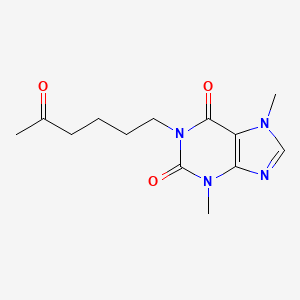Attribution Statement: LactMed is a registered trademark of the U.S. Department of Health and Human Services.
NCBI Bookshelf. A service of the National Library of Medicine, National Institutes of Health.
Drugs and Lactation Database (LactMed®) [Internet]. Bethesda (MD): National Institute of Child Health and Human Development; 2006-.
CASRN: 6493-05-6

Drug Levels and Effects
Summary of Use during Lactation
Limited data indicate that pentoxifylline is poorly excreted into breastmilk. It would not be expected to cause any adverse effects in breastfed infants, especially if the infant is older than 2 months.
Drug Levels
Maternal Levels. Five women who had been breastfeeding for at least 6 weeks received a single 400 mg oral dose of a sustained-release form of pentoxifylline. The average total milk concentration of pentoxifylline plus its 3 active metabolites was 419 mcg/L at 2 hours after the dose and 982 mcg/L at 4 hours.[1] Using the peak milk level data from this study, an exclusively breastfed infant would receive an estimated maximum of 147 mcg/kg daily with this maternal dosage regimen or about 2% of the maternal weight-adjusted dosage.
Infant Levels. Relevant published information was not found as of the revision date.
Effects in Breastfed Infants
Relevant published information was not found as of the revision date.
Effects on Lactation and Breastmilk
Relevant published information was not found as of the revision date.
References
- 1.
- Witter FR, Smith RV. The excretion of pentoxifylline and its metabolites into human breast milk. Am J Obstet Gynecol. 1985;151:1094–7. [PubMed: 3985069]
Substance Identification
Substance Name
Pentoxifylline
CAS Registry Number
6493-05-6
Drug Class
Breast Feeding
Lactation
Hematologic Agents
Phosphodiesterase Inhibitors
Platelet Aggregation Inhibitors
Xanthines
Disclaimer: Information presented in this database is not meant as a substitute for professional judgment. You should consult your healthcare provider for breastfeeding advice related to your particular situation. The U.S. government does not warrant or assume any liability or responsibility for the accuracy or completeness of the information on this Site.
- User and Medical Advice Disclaimer
- Drugs and Lactation Database (LactMed) - Record Format
- LactMed - Database Creation and Peer Review Process
- Fact Sheet. Drugs and Lactation Database (LactMed)
- Drugs and Lactation Database (LactMed) - Glossary
- LactMed Selected References
- Drugs and Lactation Database (LactMed) - About Dietary Supplements
- Breastfeeding Links
- PubChem SubstanceRelated PubChem Substances
- PubMedLinks to PubMed
- Review Dyphylline.[Drugs and Lactation Database (...]Review Dyphylline.. Drugs and Lactation Database (LactMed®). 2006
- Review Dimenhydrinate.[Drugs and Lactation Database (...]Review Dimenhydrinate.. Drugs and Lactation Database (LactMed®). 2006
- Review Nimodipine.[Drugs and Lactation Database (...]Review Nimodipine.. Drugs and Lactation Database (LactMed®). 2006
- Review Probenecid.[Drugs and Lactation Database (...]Review Probenecid.. Drugs and Lactation Database (LactMed®). 2006
- Review Caffeine.[Drugs and Lactation Database (...]Review Caffeine.. Drugs and Lactation Database (LactMed®). 2006
- Pentoxifylline - Drugs and Lactation Database (LactMed®)Pentoxifylline - Drugs and Lactation Database (LactMed®)
- OMIM Links for GEO Profiles (Select 77974078) (2)OMIM
- 3D structures for Gene (Select 6884) (4)Structure
Your browsing activity is empty.
Activity recording is turned off.
See more...
